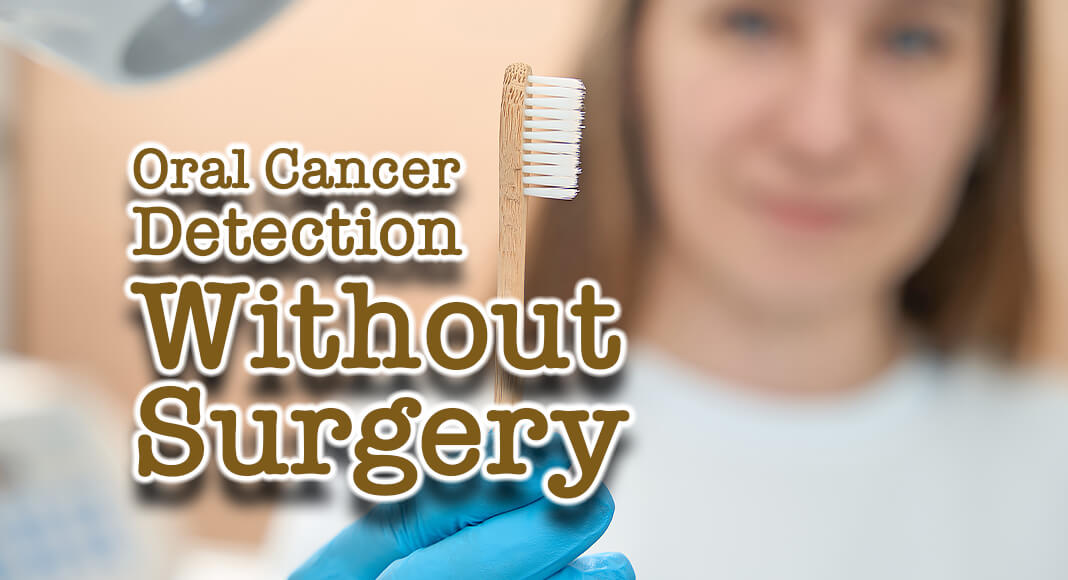
Mega Doctor News
By University of Illinois Chicago
By Rob Mitchum
Newswise — A new test invented by University of Illinois Chicago researchers allows dentists to screen for the most common form of oral cancer with a simple and familiar tool: the brush.
The diagnostic kit, created and patented by Guy Adami and Dr. Joel Schwartz of the UIC College of Dentistry, uses a small brush to collect cells from potentially cancerous lesions inside the mouth. The sample is then analyzed for genetic signals of oral squamous cell carcinoma, the ninth most prevalent cancer globally.
This new screening method, which is currently seeking commercialization partnerships, improves upon the current diagnostic standard of surgical biopsies — an extra referral step that risks losing patients who sometimes don’t return until the cancer progresses to more advanced, hard-to-treat stages.
“So many patients get lost; they don’t follow up,” said Adami, associate professor of oral medicine and diagnostic sciences. “We’ve tried to keep our focus mainly on early Stage 1 and 2 cancers, so it actually works with the cancers that you want to detect.”
The detection system works by looking for small segments of genetic material called microRNA that regulate the expression of genes. Research conducted by Adami and Schwartz found an expression signature of 40 microRNA sequences that can distinguish between a tumor and normal tissue with over 90% accuracy.
Importantly, their test also worked using epithelial cells, the outermost layer of cells in a patient’s mouth. These cells can be easily collected in less than a minute of gentle brushing — no numbing required — by a dentist or nurse, who then places the brush in a tube of solution and sends it to a lab for microRNA analysis. Results can be returned to the clinic in days with the current version of the diagnostic test.
“We were the first to observe that brush biopsy samples actually work quite well when you use microRNA,” Adami said. “All you need is a good light and the brushes.”
In addition to the convenience of the collection method, the brush biopsy also provides several other advantages, the authors said. Surgical biopsies often collect a mixture of cell types, making subsequent analysis more complicated, and risk spreading cancerous cells to other areas of the mouth. And unlike blood tests that survey generally for genetic signals of cancer, the brush method only collects cells from a single site where treatment can be focused if a malignancy is detected.
“If you compare what we do, which is site-specific targeting of tissue, to the other tests out there, they don’t have a targeting of where the tumors actually are,” said Schwartz, professor of oral medicine and diagnostic sciences. “That makes it harder to start treatment rapidly after detection.”
The inventors hope that the new test will make screening easier to perform, particularly in patient populations that don’t receive regular dental care or have a higher incidence of oral squamous cell carcinoma. For example, Black men have a dramatically lower survival rate with the disease compared with white, Hispanic and Asian men. Usage of the invention in nonclinical settings would allow earlier cancer detection in high-risk populations.
The technology may also eventually be useful in diagnosing other oral diseases through their own unique microRNA signatures, the authors said. To commercialize the test, Adami and Schwartz formed a company called Arphion Diagnostics that has worked with the UIC Office of Technology Management. But they continue to look for business partners to help take the test into dental clinics.
“There are 600 different diseases that occur in the mouth, and a number of these have already been characterized with microRNAs,” Schwartz said. “We could use the same approach and really have a profound impact on these kinds of disease.”
In addition to Adami and Schwartz, research and design of the diagnostic test was conducted by oral and maxillofacial surgeon Dr. Antonia Kolokythas, a key member of the project who helped optimize the methodology and identified and collected brush samples from the first group of patients. The work was supported by grants from the National Science Foundation and the National Cancer Institute. Adami and Schwartz are also members of the University of Illinois Cancer Center.









